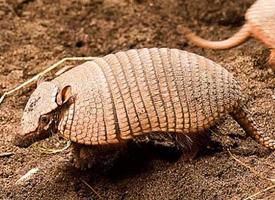
Váhy a míry
| Délka | 40 cm |
|---|
Popis zvířete
The Big Hairy Armadillo, scientifically known as Chaetophractus villosus, is a fascinating and distinctive creature native to South America. This species is one of the larger members of the armadillo family, and it is particularly notable for its coarse, dense fur, which distinguishes it from its more sparsely haired relatives.Physically, the Big Hairy Armadillo typically measures between 30 to 40 centimeters in length, not including its tail, which can add an additional 15 to 17 centimeters. It has a robust and compact body covered in a protective shell. This shell is composed of bony plates called osteoderms, which are covered by leathery skin. The plates are arranged in bands that allow the armadillo some flexibility. The body armor is complemented by the presence of dense, long hair that protrudes from under the plates, providing an additional layer of insulation and protection against the elements and predators.
The coloration of the Big Hairy Armadillo can vary from dark brown to yellowish-white, with the hair being generally lighter than the armor. Its underparts are typically softer and less densely armored, allowing for more flexibility. The creature is equipped with strong, clawed limbs that are highly adapted for digging. These claws enable it to excavate burrows for shelter and to unearth its prey, which includes a variety of insects, larvae, and small vertebrates.
The Big Hairy Armadillo possesses a keen sense of smell, which it utilizes to locate food. Its diet is omnivorous, including not only animal prey but also plant matter, making it a versatile forager. This dietary flexibility is advantageous in the varied environments it inhabits, which range from grasslands to forests and even semi-desert areas.
Socially, the Big Hairy Armadillo tends to be a solitary creature, coming together with others only for mating purposes. It is primarily nocturnal, although it may be active during the day in cooler weather. The armadillo's burrowing habit not only provides it with shelter but also affects the ecosystem by aerating the soil and facilitating seed dispersal.
Reproduction in this species involves the female giving birth to one to three offspring after a gestation period of approximately 60 to 75 days. The young are born with soft, leathery armor that hardens as they mature. They are weaned and ready to fend for themselves within a few months.
Despite its resilience and adaptability, the Big Hairy Armadillo faces threats from habitat loss and hunting. In some regions, it is hunted for its meat and shell, and its habitat is increasingly being encroached upon by agricultural expansion. However, it is not currently considered endangered, thanks in part to its wide distribution and generalist habitat requirements.
In conclusion, the Big Hairy Armadillo (Chaetophractus villosus) is a remarkable and adaptable animal, equipped with unique physical adaptations that allow it to thrive in diverse South American environments. Its role in the ecosystem, dietary flexibility, and intriguing behaviors make it a subject of interest not only for scientific study but also for conservation efforts to ensure its continued survival in the wild.
Nové fotografie zvířat
Top 10 zvířat
- Chinese water dragon (Physignathus cocincinus)
- Galápagos tortoise (Geochelone nigra complex)
- Dolphin gull (Leucophaeus scoresbii)
- Japanese macaque (Macaca fuscata)
- Colombian red howler (Alouatta seniculus)
- Sea urchins (Echinoidea)
- Diana monkey (Cercopithecus diana)
- Moustached guenon (Cercopithecus cephus)
- Common reed warbler (Acrocephalus scirpaceus)
- Common house mosquito (Culex pipiens)